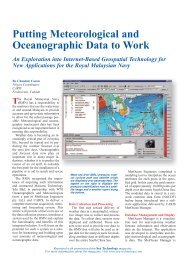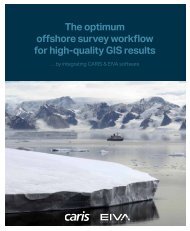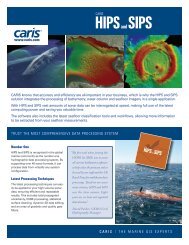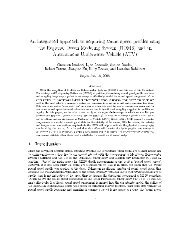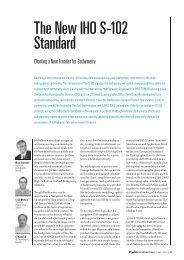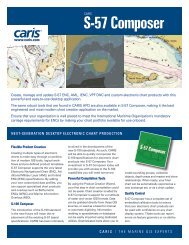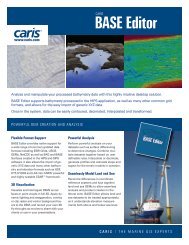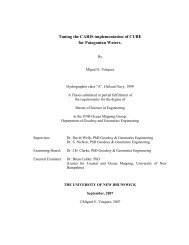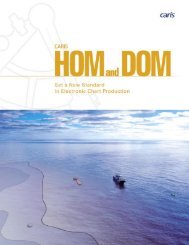Addressing the Need for Bathymetric Data Management.pdf - Caris
Addressing the Need for Bathymetric Data Management.pdf - Caris
Addressing the Need for Bathymetric Data Management.pdf - Caris
- No tags were found...
You also want an ePaper? Increase the reach of your titles
YUMPU automatically turns print PDFs into web optimized ePapers that Google loves.
(Above) A simplified representation of <strong>the</strong>file-based workflow <strong>for</strong> <strong>the</strong> bathymetricdata management.(Right) Bathy <strong>Data</strong>BASE and HPD workflow.Bathy <strong>Data</strong>BASE SolutionBathy <strong>Data</strong>BASE is a software suitecomposed of a client application,database server and database administrationtools. The processing toolsavailable in <strong>the</strong> client application canalso be accessed as a standalonedesktop application.Workflow. An intrinsic part of <strong>the</strong>Bathy <strong>Data</strong>BASE system is <strong>the</strong> flexibletool set provided to evaluate and editdata sets from third-party sources,preparing <strong>the</strong> data to meet <strong>the</strong> standardsof an organization so <strong>the</strong>y canbe used to enhance <strong>the</strong> organization’sdata holdings and coverage. All validdata can potentially be used in <strong>the</strong>creation of products such as nauticalcharts.A typical chart production workflowwould have data coming into <strong>the</strong>system from various sources, withsome data preparation and validationtaking place using <strong>the</strong> tools in BASEManager. Validated data and metadatawould be loaded into <strong>the</strong> Bathy<strong>Data</strong>BASE server. Measurements suchas soundings, contours and depthareas would be generated from <strong>the</strong>source data.<strong>Data</strong>base Architecture. The Bathy<strong>Data</strong>BASE system is based on a clientserverdesign. The system supports <strong>the</strong>storage and management of bathymetricdata in <strong>the</strong> BASE Surfaces,bathymetric attributed grid files andsounding set <strong>for</strong>mats.<strong>Data</strong> are loaded into <strong>the</strong> Bathy<strong>Data</strong>BASE server as survey and sur-face objects. Each surveyand surface object hasassociated metadata basedon S-57 attribution—<strong>the</strong> standardused <strong>for</strong> <strong>the</strong> exchange of digitalhydrographic data between nationalhydrographic agencies and <strong>for</strong> distributionto stakeholders. The catalogsdefining <strong>the</strong> objects and <strong>the</strong>ir attributesare in extensible markup language<strong>for</strong>mat and are customizable by <strong>the</strong>user.The object metadata and systemgeneratedbounding polygon coordinatesare stored in <strong>the</strong> database. Theserver software manages all interactionsbetween <strong>the</strong> client applicationand <strong>the</strong> objects in <strong>the</strong> database. Ithandles transactions requested by <strong>the</strong>client application (<strong>the</strong> primary clientbeing BASE Manager) <strong>for</strong> data loading,data extraction and object editing.Server resources are also used in<strong>the</strong> creation of generalized and deconflictedsurfaces and <strong>the</strong> generationof bathymetric products(i.e., contours) from sources in<strong>the</strong> database.The objects resulting from <strong>the</strong>de-confliction process are also storedin <strong>the</strong> database. Both <strong>the</strong> resultingsurface and <strong>the</strong> supersede decisionsdefined <strong>for</strong> <strong>the</strong> de-confliction aremaintained, <strong>the</strong> surface is stored as asurface object and <strong>the</strong> supersededecisions are stored in a product profileobject. The product profile objectcarries in<strong>for</strong>mation about <strong>the</strong> areathat has been superseded and <strong>the</strong>parameters of <strong>the</strong> supersede decision.The Bathy <strong>Data</strong>BASE solution wasdesigned to be scalable in terms ofaccommodating <strong>the</strong> types and volumeof data currently being surveyedwith multibeam and lidar systems.The scalability also addresses <strong>the</strong>need <strong>for</strong> coverage on a global scale asneeded by some organizations thathave a mandate beyond sovereignwaters.
“The logical extension of any data managementsystem is <strong>the</strong> distribution of those resources toclients.”Distribution. The logical extensionof any data management system is <strong>the</strong>distribution of those resources toclients. Due to <strong>the</strong> massive improvementsin communication systemsover <strong>the</strong> past several years, deliveryvia <strong>the</strong> Web has become an efficientmechanism <strong>for</strong> disseminating geospatialin<strong>for</strong>mation.The CARIS solution <strong>for</strong> spatial datadistribution on <strong>the</strong> Web is SpatialFusion Enterprise. This technologyprovides an interface to spatial data,including hydrographic in<strong>for</strong>mationand bathymetric data. Via <strong>the</strong> Webinterface, <strong>the</strong> user has <strong>the</strong> ability toview, query and select data sources.Spatial Fusion Enterprise implements<strong>the</strong> Open Geospatial ConsortiumInc. ®(Wayland, Massachusetts)specifications <strong>for</strong> Web map service.This allows data to be easily sharedamong organizations and allows connectionsto external Web sites <strong>for</strong>viewing additional sources of data.Pilot Project: CHS Quebec RegionAs part of a larger initiative to adoptdatabase-driven technology in <strong>the</strong>processing and management ofbathymetry and hydrographic data,CHS’s Quebec, Canada, region isevaluating Bathy <strong>Data</strong>BASE.The CHS Quebec region is in <strong>the</strong>early stages of evaluating Bathy <strong>Data</strong>-BASE to improve <strong>the</strong> management of<strong>the</strong> bathymetry results from varioustypes of surveys. Sources of bathymetryinclude new and historical singlebeam,MBES, lead line and o<strong>the</strong>r systems.CHS has a mandate to manageall bathymetry sources <strong>for</strong> Canadaand to provide <strong>the</strong>se data to itsclients. The goal of investigating newways of managing <strong>the</strong>se data is to beable to respond in <strong>the</strong> most efficientway to all requests from its clients.Using a bathymetry data managementsystem like Bathy <strong>Data</strong>BASEallows bathymetry extracts to be tailoredto meet a specific set of criteria.The criteria may include specifications<strong>for</strong> epoch, resolution and attribution.The data are provided to awide variety of clients <strong>for</strong> applicationsin navigation, science and engineering.File-Based Workflow. The currentpractice in place <strong>for</strong> <strong>the</strong> managementof bathymetric data is <strong>the</strong> use of NTXfiles—CARIS exchange <strong>for</strong>mat files.All data are converted to a commondatum and cartographic projection tomake <strong>the</strong> future analysis easier. In <strong>the</strong>case of multibeam data, <strong>the</strong>re is anextra step in <strong>the</strong> process. The originalfile is decimated to a sounding densitythat makes <strong>the</strong> files usable withoutlosing too much detail. After <strong>the</strong> conversionto a common <strong>for</strong>mat, analysisis done by comparison to files thatcover <strong>the</strong> same area. A decision ismade to modify <strong>the</strong> status (suppressedor not suppressed) of data if achange is required.Once this analysis is complete, <strong>the</strong>new file is accessible to o<strong>the</strong>r users.All <strong>the</strong> steps need to be recordedmanually in <strong>the</strong> CHS metadata database(CHSDir) <strong>for</strong> tracking. To access<strong>the</strong> data, <strong>the</strong> user needs to utilizeCHSDir to make a query on <strong>the</strong>attribute that <strong>the</strong>y are looking <strong>for</strong>(type of survey, geographic query,etc.). Even if only a small area of alarge file is needed, <strong>the</strong> entire fileneeds to be imported. The user needsto manipulate <strong>the</strong> files to access <strong>the</strong>area of interest.Interaction with CHSDir makes <strong>the</strong>management complex and restrictivein terms of access and distribution toall clients. The file management isrestricted in <strong>the</strong> interaction by <strong>the</strong>database, which provides only onewaycommunication.Bathy <strong>Data</strong>BASE Workflow. Thegoal of this pilot project is to explore<strong>the</strong> possibilities offered in <strong>the</strong> newCARIS technology to complete <strong>the</strong>ping-to-chart workflow in a productionenvironment. CHS would like toimprove its bathymetric data managementby developing interaction withits internal databases (two-way communication)and improving accessibilityto <strong>the</strong> community.A bathymetric data managementsolution must have some basic qualitiesin order to fit into <strong>the</strong> CHS work-flow process: interaction with existingdatabases (CHSDir, CARIS HPD),seamless integration with <strong>the</strong> technologiesused in adjacent processes(upstream [host-based intrusion-preventionsystem] and downstream[HPD]), datum adjustment (management),minimal loss of in<strong>for</strong>mation (asclose as possible to <strong>the</strong> source), traceabilityof data from source to product,easy access to <strong>the</strong> data <strong>for</strong> internaland external users (Web access), per<strong>for</strong>manceand robustness of <strong>the</strong> applicationand evaluation of <strong>the</strong> export<strong>for</strong>mats by <strong>the</strong> clients.Investigation of Bathy <strong>Data</strong>BASE.The effective management of bathymetricdata is crucial to CHS. Thedevelopment of new tools and datamanagement solutions allows CHS toexplore new opportunities to upgradeor adjust workflow practices.Two principles exist <strong>for</strong> <strong>the</strong> managementof data: load data as a navigationsurface (BASE Surface) or apoint stored file (sounding set). CHStested both possibilities to evaluatewhich of those two would bestaddress its needs.The area coverage selected <strong>for</strong> <strong>the</strong>tests was limited to Quebec Harbor,which contains around 50 sourcedocuments, from lead line to multibeamdata. Be<strong>for</strong>e loading both testdatabases, all files were converted toa common datum and coordinatesystem.Historical sparse data were convertedto a sounding set and BASESurface <strong>for</strong>mat. <strong>Data</strong> with enoughsounding density were converteddirectly to BASE Surfaces. After <strong>the</strong>conversion, a survey was created <strong>for</strong>each of <strong>the</strong> files, and metadata wereadded manually using in<strong>for</strong>mationcontained in CHSDir.The data were loaded into <strong>the</strong> databaseattached to <strong>the</strong> previouslydefined survey. Once <strong>the</strong> data werecompletely loaded into both databases,testing began on <strong>the</strong> supersedingrules at <strong>the</strong> extraction.While access to <strong>the</strong> data provedefficient and easy, initial tests did notgive <strong>the</strong> anticipated results. CHS hadexpected that conflicts would besolved at a data-set level instead of at<strong>the</strong> node level. Fur<strong>the</strong>r review of <strong>the</strong>results now must be completed inorder to determine if <strong>the</strong> old methodsare still valid or necessary. Discussionwith o<strong>the</strong>r CHS regions or even o<strong>the</strong>r



